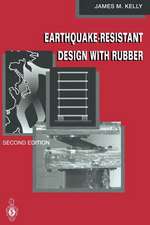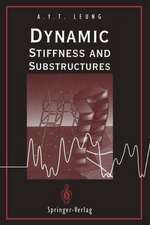Analysis and Optimization of Prismatic and Axisymmetric Shell Structures: Theory, Practice and Software
Autor Ernest Hinton, Johann Sienz, Mustafa Özakcaen Limba Engleză Hardback – 7 oct 2003
| Toate formatele și edițiile | Preț | Express |
|---|---|---|
| Paperback (1) | 1227.84 lei 6-8 săpt. | |
| SPRINGER LONDON – 7 oct 2012 | 1227.84 lei 6-8 săpt. | |
| Hardback (1) | 1234.14 lei 6-8 săpt. | |
| SPRINGER LONDON – 7 oct 2003 | 1234.14 lei 6-8 săpt. |
Preț: 1234.14 lei
Preț vechi: 1505.05 lei
-18% Nou
Puncte Express: 1851
Preț estimativ în valută:
236.15€ • 247.22$ • 195.40£
236.15€ • 247.22$ • 195.40£
Carte tipărită la comandă
Livrare economică 05-19 aprilie
Preluare comenzi: 021 569.72.76
Specificații
ISBN-13: 9781852334215
ISBN-10: 1852334215
Pagini: 532
Ilustrații: XXXII, 496 p.
Dimensiuni: 155 x 235 x 28 mm
Greutate: 0.92 kg
Ediția:2003
Editura: SPRINGER LONDON
Colecția Springer
Locul publicării:London, United Kingdom
ISBN-10: 1852334215
Pagini: 532
Ilustrații: XXXII, 496 p.
Dimensiuni: 155 x 235 x 28 mm
Greutate: 0.92 kg
Ediția:2003
Editura: SPRINGER LONDON
Colecția Springer
Locul publicării:London, United Kingdom
Public țintă
ResearchDescriere
Shell-type structures can be found almost everywhere. They appear in natural forms but also as man-made, load-bearing components in diverse engineering systems. Mankind has struggled to replicate nature’s optimization of such structures but using modern computational tools it is now possible to analyse, design and optimise them systematically. Analysis and Optimization of Prismatic and Axisymmetric Shell Structures features: comprehensive coverage of the background theory of shell structures; development and implementation of reliable, creative and efficient computational tools for static and free-vibration analysis and structural optimization of variable-thickness shells and folded-plate structures; integrated computer-aided curve and surface modelling tools and automatic mesh generation, structural analysis sensitivity analysis and mathematical programming methods; well-documented, downloadable Fortran software for these techniques using finite element and finite strip simulations which can be readily adapted by the reader for the solution of practical problems or for use within a teaching or research environment. Written by leading experts in finite element and finite strip methods, Analysis and Optimization of Prismatic and Axisymmetric Shell Structures will be of great interest to researchers in structural mechanics and in automotive, aerospace and civil engineering as well as to designers from all fields using shell structures for their strength-per-unit-mass advantages.
Cuprins
I: Introduction.- 1 Introduction.- 1.1 Background.- 1.2 Previous work.- 1.2.1 Structural shape optimization of shells and folded plates under static conditions.- 1.2.2 Vibrating shells of revolution.- 1.2.3 Vibrating prismatic shells and folded plates.- 1.3 Classification of structural optimization problems.- 1.3.1 Classification based on mode of behaviour.- 1.3.2 Classification according to type of design variable.- 1.4 Classification of shells.- 1.4.1 Indian Standard classification of shells and folded plates.- 1.4.2 Simplified classification of shells and folded plates.- 1.4.3 Summary of structures considered.- 1.5 Computer-aided shape definition.- 1.5.1 Shape definition of shells of revolution and prismatic shells.- 1.6 Element technology.- 1.6.1 Elements for shells of revolution.- 1.6.2 Strips for prismatic shells.- 1.7 Automatic mesh generation.- 1.7.1 Automatic mesh generation for shells of revolution and prismatic shells.- 1.8 Structural shape optimization.- 1.8.1 The basic algorithm.- 1.8.2 Sensitivity analysis.- 1.8.3 Sensitivity analysis of static response.- 1.8.4 Sensitivity analysis of dynamic problems.- 1.8.5 Selection and linking of design variables.- 1.8.6 Selection of constraint points.- 1.8.7 Optimization algorithm.- 1.9 Typical shell problems treated.- 1.10 Software developed in this book.- 1.11 Layout of the book.- References.- 2 Structural Shape Definition and Automatic Mesh Generation with contributions from NVR Rao.- 2.1 General perspective.- 2.2 Structural shape definition.- 2.2.1 Three equivalent representations of a parametric cubic spline.- 2.2.2 The cubic B-spline representation.- 2.2.3 Terminology.- 2.2.4 Computer implementation.- 2.2.5 Specification of end condition of splines.- 2.3 Structural thickness definition.- 2.4 Automatic mesh generation.- 2.4.1 General requirements.- 2.4.2 Algorithm for mesh generation.- 2.5 Shape definition and mesh generation in structural analysis.- 2.6 Shape definition and mesh generation in structural optimization.- 2.6.1 Shape design variables.- 2.6.2 Selection of thickness design variables.- 2.6.3 Linking of design variables.- 2.6.4 Perturbation of design variables.- 2.6.5 Prescribed move directions.- 2.7 Other applications of the present tools.- References.- 3 Structural Optimization Methods and Algorithms.- 3.1 General perspective.- 3.1.1 Problem classification.- 3.1.2 Problem definition and formulation.- 3.1.3 Basic algorithm and three-columns concept.- 3.1.4 Other important aspects.- 3.2 Optimization algorithms.- 3.2.1 Overview.- 3.2.2 Mathematical programming.- 3.2.3 Genetic algorithms.- 3.2.4 Approximation concepts.- 3.3 Sensitivity analysis.- 3.3.1 Overview.- 3.3.2 Global finite differences.- 3.3.3 Semi-analytical method.- 3.3.4 Analytical or direct sensitivity method.- 3.3.5 Adjoint variable method.- 3.3.6 Accuracy assessment.- 3.4 Concluding remarks.- References.- II: Static Analysis and Optimization.- 4 Basic Finite Element Formulation for Shells of Revolution.- 4.1 General perspective.- 4.2 Basic formulation.- 4.3 Finite element idealization.- 4.4 Strain energy evaluation.- 4.5 Benchmark examples.- 4.5.1 Cylindrical tank with non-uniform wall thickness.- 4.5.2 Clamped circular plate.- 4.5.3 Spherical dome under uniform pressure.- 4.5.4 Toroidal shell under internal pressure.- 4.6 Closing remarks.- References.- 5 Basic Finite Strip Formulation for Prismatic Shells with contributions from NVR Rao.- 5.1 General perspective.- 5.1.1 Preamble.- 5.1.2 Simply supported Euler-Bernoulli beam.- 5.1.3 Simply supported Timoshenko beam.- 5.2 Right prismatic shells.- 5.2.1 Basic formulation.- 5.2.2 Finite strip idealization.- 5.2.3 Branched strips.- 5.3 Benchmark examples.- 5.3.1 Plates.- 5.3.2 Box-girder bridges.- 5.3.3 Cylindrical shells.- 5.4 Prismatic structures with curved planform.- 5.4.1 Basic formulation.- 5.4.2 Branched strips.- 5.5 Benchmark examples.- 5.5.1 Comparisons with known solutions for right structures analyzed as structures with curved planform.- 5.5.2 Comparison with known solutions for structures with curved planform.- 5.5.3 New solutions for structures with curved planform.- References.- 6 Structural Optimization of Shells of Revolution and Prismatic Shells with contributions from NVR Rao.- 6.1 General perspective.- 6.2 Problem definition.- 6.2.1 Selection of objective function for the problem.- 6.2.2 Selection of constraints for the problem.- 6.3 Sensitivity analysis.- 6.3.1 Analytical method.- 6.3.2 Semi-analytical method.- 6.3.3 Stress resultant gradients.- 6.3.4 Equivalent stress derivative.- 6.3.5 Global finite difference method.- 6.3.6 Volume gradient.- 6.3.7 Strain energy gradient.- 6.4 Shells of revolution examples.- 6.4.1 Clamped circular plate subjected to uniformly distributed load.- 6.4.2 Cylindrical tank under hydrostatic pressure.- 6.4.3 Spherical shell under ring load.- 6.5 Right prismatic shells and folded plates examples.- 6.5.1 Square plates subjected to uniformly distributed load.- 6.5.2 Plates on elastic foundations.- 6.5.3 Single-cell right box-girder bridge.- 6.5.4 Cylindrical shell roof.- 6.5.5 Pinched cylindrical shell.- 6.6 Prismatic shells with curved planform examples.- 6.6.1 Plates with curved planform subjected to uniformly distributed load.- 6.6.2 Single-cell curved box-girder bridge.- 6.6.3 Pinched cylindrical shell with curved planform.- 6.7 Closing remarks.- References.- III: Free Vibration Analysis and Optimization.- 7 Basic Finite Element Formulation for Vibrating Axisymmetric Shells.- 7.1 General perspective.- 7.1.1 Analysis methods.- 7.1.2 Applications.- 7.2 Structural analysis and finite element formulation.- 7.2.1 Finite element formulation.- 7.2.2 Finite element idealization.- 7.2.3 Branched elements.- 7.3 Examples.- 7.3.1 Thin circular plate.- 7.3.2 Annular plates with linearly varying thickness.- 7.3.3 Hemispherical dome.- 7.3.4 Conical shell with variable thickness.- 7.3.5 Cone-cylinder combination.- 7.3.6 Hyperboloidal shell.- 7.3.7 Hermetic capsule.- 7.3.8 Hermetic can.- 7.3.9 Bells.- References.- 8.1 Introduction.- 8.2 Prismatic shells with rectangular planform.- 8.2.1 Basic finite strip formulation.- 8.2.2 Finite strip idealization.- 8.2.3 Branched strips.- 8.3 Examples.- 8.3.1 Square plates.- 8.3.2 Variable-thickness plates.- 8.3.3 Stiffened panel.- 8.3.4 Cylindrical shell.- 8.3.5 Cylinders with interior partitions.- 8.3.6 Two-cell right box-girder bridge.- 8.4 Prismatic structures with curved planform.- 8.4.1 Basic finite strip formulation.- 8.4.2 Finite strip idealization.- 8.4.3 Branched strips.- 8.5 Examples.- 8.5.1 Annular sector plates.- 8.5.2 Two-cell box-girder bridge with a curved planform.- 8.5.3 Right cylinders with interior partitions.- 8.5.4 Cylinders with interior partitions and curved planforms.- References.- 9 Structural Shape Optimization of Vibrating Axisymmetric and Prismatic Shells.- 9.1 General perspective.- 9.2 Problem definition.- 9.2.1 Selection of objective function.- 9.2.2 Selection of design variables.- 9.2.3 Selection of constraints.- 9.2.4 Bounds on design variables.- 9.3 Sensitivity analysis.- 9.3.1 Derivative evaluation.- 9.3.2 Analytical method.- 9.3.3 Semi-analytical method.- 9.3.4 Finite difference method.- 9.3.5 Derivative of volume.- 9.4 Axisymmetric shells.- 9.5 Axisymmetric shell examples.- 9.5.1 Circular plates.- 9.5.2 Conical shell.- 9.5.3 Spherical shells.- 9.5.4 Branched shell.- 9.5.5 Bells.- 9.6 Prismatic folded plates and shells.- 9.7 Prismatic folded plates and shells: examples.- 9.7.1 Square plates.- 9.7.2 Stiffened panel.- 9.7.3 Cylindrical shell.- 9.7.4 Box-girder bridge.- 9.8 Prismatic shells with curved planform: examples.- 9.8.1 Annular sector plates.- 9.8.2 Cylindrical shell segment with curved planform.- 9.8.3 Box-girder bridge.- References.- IV: Dynamic and Buckling Analysis and Optimization.- 10 Buckling Analysis and Optimization of Plates and Shells.- 10.1 Prismatic plates.- 10.2 Strip formulation for prismatic plates with rectangular planform.- 10.2.1 Strain energy.- 10.3 Prismatic plate examples.- 10.3.1 Isotropic plates of uniform thickness.- 10.3.2 Square variable-thickness (Sh/Sh/Sh/Sh) isotropic plates under uniaxial load.- 10.3.3 Stiffened panels under uniaxial load.- 10.4 Axisymmetric plates and shells.- 10.5 Finite element formulation for axisymmetric plates and shells.- 10.5.1 Strain energy.- 10.6 Axisymmetric examples.- 10.6.1 Circular plates.- 10.6.2 Annular plates.- 10.6.3 Thin cylindrical shells.- 10.7 Buckling optimization of structures.- 10.8 Optimization examples for prismatic and folded plates.- 10.8.1 Rectangular plate examples.- 10.8.2 Stiffened panels.- 10.9 Optimization examples for circular and annular plates.- 10.9.1 Circular plates.- 10.9.2 Annular plates.- References.- 11 Basic Dynamic Analysis of Plates, Solids of Revolution and Finite Prism Type Structures.- 11.1 Analytical models for the dynamic analysis of rectangular simply supported plates.- 11.1.1 Introduction.- 11.1.2 Governing equations.- 11.1.3 Closed-form solution: vibration analysis.- 11.1.4 Stability analysis.- 11.1.5 Dynamic transient analysis.- 11.1.6 Introduction to examples.- 11.1.7 Examples: free vibrations.- 11.1.8 Examples: initially stressed vibration and buckling.- 11.1.9 Examples: transient dynamic analysis.- 11.2 Finite element analysis of solids of revolution.- 11.2.1 Introduction.- 11.2.2 Basic formulation.- 11.2.3 Solid of revolution element.- 11.2.4 Solid of revolution examples.- 11.3 Finite prism models.- 11.3.1 Basic formulation.- 11.3.2 The finite prism method.- 11.3.3 Example.- 11.4 Related closed-form static analysis of rectangular simply supported plates.- 11.4.1 Introduction.- 11.4.2 Closed-form solutions.- 11.4.3 Fourier series representation of the loads.- 11.4.4 Sample solutions.- References.- Appendices.- A The Evaluation of certain Strain Terms.- B Evaluation of the Radius of Curvature R.- C Musical Scales and Temperament.- Author Index.- V: CD-ROM.- A CD-Rom Overview and Installation Instructions.- A.1 CD-Rom overview.- A.1.1 Software packages.- A.1.2 User manuals.- A.1.3 Tools and other resources.- A.2 Installation instructions of PCs.- A.3 Internet links.- B Documentation and User Instructions of Program “SANOPT-S”.- B.1 Program documentatio.- B.1.1 Overview of the program.- B.1.2 Block structure and main routines.- B.1.3 File structures.- B.1.4 Main dimensions and limitations of the program.- B.2 Input instructions.- B.2.1 Main structure of input data.- B.2.2 User hints.- B.3 Specimen input data files.- B.3.l Cylindrical tank under hydrost atic pressure.- B.3.2 Single-cell right box-girder bridge.- B.3.3 Pinched cylindrical shell with curved planform.- References.- Documentation and User Instructions of Program “SANOPT-F”.- C.1 Program documentation.- C.1.1 Overview of the program.- C.1.2 Block structure and main routines.- C.1.3 File structures.- C.1.4 Main dimensions and limitations of the program.- C.2 Input instructions.- C.2.1 Main structure of input data.- C.2.2 User hints.- C.3 Specimen input data files.- C.3.1 Conical shell.- C.3.2 Square plate.- C.3.3 Cylindrical shell segment with curved planform.- References.- D Documentation and User Instructions of Program “SANOPT-P”.- D.1 Program documentation.- D.1.1 Overview of the program.- D.1.2 Block structure and main routines.- D.1.3 File structures.- D.1.4 Main dimensions and limitations of the program.- D.2 Input instructions.- D.2.1 Main st ruct ure of input data file for static problems.- D.2.2 Main structure of input dat a file for free-vibration and buckling problems.- D.3 Specimen input data files.- D.3.1 Cylindrical shell roof subjected to self-weight loading.- D.3.2 Thin circular plate.- E Documentation and User Instructions of Program “PREP”.- E.1 Program documentation.- E.1.1 Overview of the program.- E.1.2 Block structure and main routines.- E.1.3 File structures.- E.1.4 Main dimensions and limitations of the program.- E.2 Input instructions.- E.2.1 Main structure of input data.- E.2.2 User hints.- E.3 Specimen input data file.- E.3.1 Cylinder with hemispherical bottom under internal pressure.- F Documentation and User Instructions of Program “SP LINE”.- F.1 Program documentation.- F.1.1 Overview of the program.- F.1.2 Block structure and main routines.- F.1.3 File structures.- F.1.4 Main dimensions and limitations of the program.- F.2 Input instructions.- F.2.1 Main structure of input data.- F.2.2 User hints.- F.3 Specimen input data file.- F.3.1 Wheel geometry.- G Documentation and User Instructions of Program “OPTIMIZE”.- G.1 Program documentation.- G.1.1 Overview of the program.- G.1.2 Block structure and main routines.- G.1.3 File structures.- G.2 Input instructions.- G.3 Specimen user-supplied subroutines and output data file.- G.3.1 Example.- References.- H Documentation and User Instructions of Program “TRAM”.- H.1 Pro gramdocumentation.- H.1.1 Overview of the program.- H.1.2 Main routines.- H.2 Input instructions.- H.2.1 The glossary of variable names.- H.2.2 Main structure of input data.- H.3 Specimen input data files.- H.3.1 Free-vibration and buckling analysis of square plate.- I Documentation and User Instructions of Program “VISOR”.- I.1 Program documentation.- I.1.1 Overview of the program.- I.1.2 Main routines.- I.2 Input instructions.- I.2.1 The glossary of variable names.- I.2.2 Main structure of input data.- I.3 Specimen input data files.- I.3.1 Simply supported circular plate.- I.3.1 Simply supported square plate.- References.- J Documentation and User Instructions of Program “PLATES”.- J.1 Program documentation.- J.1.1 Overview of the program.- J.1.2 Main routines.- J.2 Input instructions.- J.2.1 The glossary of variable names.- J.2.2 Main structure of input data.- J.3 Specimen input data files.- J.3.1 Homogeneous isotropic rectangular thin plates.
Recenzii
From the reviews:
"The book, consisting of 5 parts, starts from introduction and then presents static analysis and optimization. Parts 3 and 4 are devoted to free-vibration analysis and optimization, and to dynamic and buckling analysis and optimization. … The book is accessible to the novice and expert alike, and can be used by students, engineers and scientists working in automotive, aerospace and civil engineering." (Stefan Jendo, Zentralblatt MATH, Vol. 1088 (14), 2006)
"The book, consisting of 5 parts, starts from introduction and then presents static analysis and optimization. Parts 3 and 4 are devoted to free-vibration analysis and optimization, and to dynamic and buckling analysis and optimization. … The book is accessible to the novice and expert alike, and can be used by students, engineers and scientists working in automotive, aerospace and civil engineering." (Stefan Jendo, Zentralblatt MATH, Vol. 1088 (14), 2006)
Caracteristici
Downloadable programs allow the theories in the book to be put into practice immediately
Their flexibility allows the reader to use them as a research tool or as a teaching aid.
The reader will learn how to integrate geometric shape definition, automatic mesh generation, accurate finite element and finite strip simulation with sensitivity analysis and mathematical programming techniques to perform both thickness and shape optimization for shell structures.
The reader will learn how to understand the basic format of efficient structural analysis codes based on finite element and finite strip analysis.
Their flexibility allows the reader to use them as a research tool or as a teaching aid.
The reader will learn how to integrate geometric shape definition, automatic mesh generation, accurate finite element and finite strip simulation with sensitivity analysis and mathematical programming techniques to perform both thickness and shape optimization for shell structures.
The reader will learn how to understand the basic format of efficient structural analysis codes based on finite element and finite strip analysis.






















